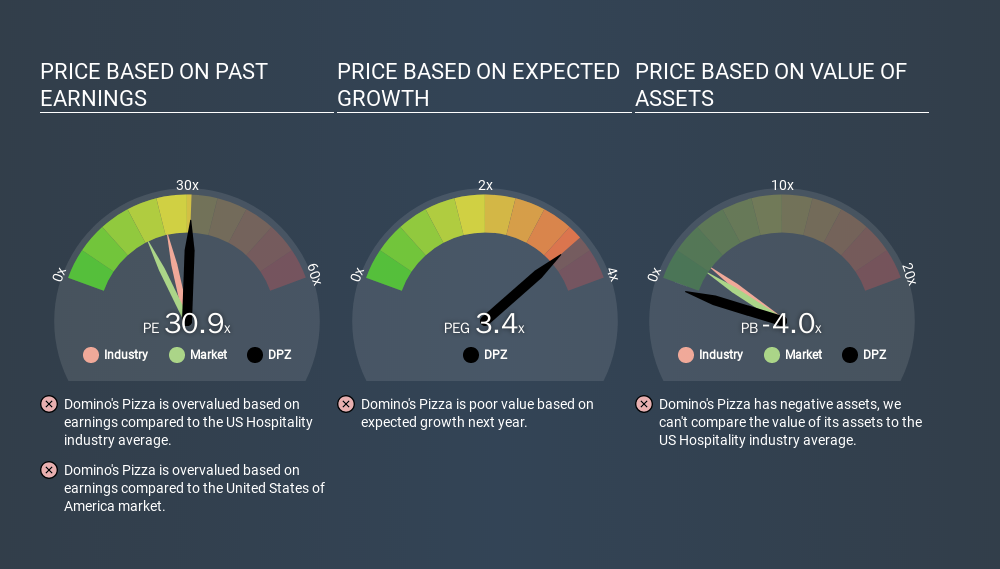- United States
- /
- Hospitality
- /
- NasdaqGS:DPZ
Is Domino's Pizza, Inc.'s (NYSE:DPZ) High P/E Ratio A Problem For Investors?

This article is written for those who want to get better at using price to earnings ratios (P/E ratios). We'll show how you can use Domino's Pizza, Inc.'s (NYSE:DPZ) P/E ratio to inform your assessment of the investment opportunity. Based on the last twelve months, Domino's Pizza's P/E ratio is 30.91. That is equivalent to an earnings yield of about 3.2%.
View our latest analysis for Domino's Pizza
How Do You Calculate Domino's Pizza's P/E Ratio?
The formula for price to earnings is:
Price to Earnings Ratio = Share Price ÷ Earnings per Share (EPS)
Or for Domino's Pizza:
P/E of 30.91 = $289.09 ÷ $9.35 (Based on the year to September 2019.)
Is A High Price-to-Earnings Ratio Good?
The higher the P/E ratio, the higher the price tag of a business, relative to its trailing earnings. That is not a good or a bad thing per se, but a high P/E does imply buyers are optimistic about the future.
How Does Domino's Pizza's P/E Ratio Compare To Its Peers?
We can get an indication of market expectations by looking at the P/E ratio. You can see in the image below that the average P/E (24.7) for companies in the hospitality industry is lower than Domino's Pizza's P/E.

Its relatively high P/E ratio indicates that Domino's Pizza shareholders think it will perform better than other companies in its industry classification. Shareholders are clearly optimistic, but the future is always uncertain. So further research is always essential. I often monitor director buying and selling.
How Growth Rates Impact P/E Ratios
Earnings growth rates have a big influence on P/E ratios. Earnings growth means that in the future the 'E' will be higher. And in that case, the P/E ratio itself will drop rather quickly. And as that P/E ratio drops, the company will look cheap, unless its share price increases.
It's great to see that Domino's Pizza grew EPS by 15% in the last year. And earnings per share have improved by 26% annually, over the last five years. With that performance, you might expect an above average P/E ratio.
A Limitation: P/E Ratios Ignore Debt and Cash In The Bank
Don't forget that the P/E ratio considers market capitalization. That means it doesn't take debt or cash into account. The exact same company would hypothetically deserve a higher P/E ratio if it had a strong balance sheet, than if it had a weak one with lots of debt, because a cashed up company can spend on growth.
While growth expenditure doesn't always pay off, the point is that it is a good option to have; but one that the P/E ratio ignores.
How Does Domino's Pizza's Debt Impact Its P/E Ratio?
Domino's Pizza has net debt equal to 28% of its market cap. You'd want to be aware of this fact, but it doesn't bother us.
The Bottom Line On Domino's Pizza's P/E Ratio
Domino's Pizza trades on a P/E ratio of 30.9, which is above its market average of 18.7. While the company does use modest debt, its recent earnings growth is very good. So on this analysis it seems reasonable that its P/E ratio is above average.
When the market is wrong about a stock, it gives savvy investors an opportunity. If the reality for a company is better than it expects, you can make money by buying and holding for the long term. So this free visual report on analyst forecasts could hold the key to an excellent investment decision.
You might be able to find a better buy than Domino's Pizza. If you want a selection of possible winners, check out this free list of interesting companies that trade on a P/E below 20 (but have proven they can grow earnings).
If you spot an error that warrants correction, please contact the editor at editorial-team@simplywallst.com. This article by Simply Wall St is general in nature. It does not constitute a recommendation to buy or sell any stock, and does not take account of your objectives, or your financial situation. Simply Wall St has no position in the stocks mentioned.
We aim to bring you long-term focused research analysis driven by fundamental data. Note that our analysis may not factor in the latest price-sensitive company announcements or qualitative material. Thank you for reading.
About NasdaqGS:DPZ
Domino's Pizza
Operates as a pizza company in the United States and internationally.
Solid track record established dividend payer.
Similar Companies
Market Insights
Community Narratives





